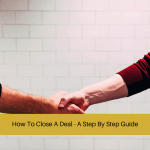
Sales Enablement – Your Ultimate Guide
If you look at companies that perform very well with their sales teams versus those that perform averagely – the difference usually will be the better company has a sales enablement strategy in place.
Sales enablement is crucial to your staff’s success, and in this guide, you’ll learn why.
In this article, we’ll cover:
- What is sales enablement?
- Why is sales enablement important?
- A sales enablement strategy
- We’ll break down the various steps required to implement your strategy
Sales Enablement – Your Ultimate Guide
What Is Sales Enablement?
Simply put; sales enablement is the process of ensuring your sales team have all the required materials needed to consistently close sales.
Depending on your business, product or service type; there are various ingredients you can add to create a successful on boarding process for your sales team.
We’ll cover some examples of this shortly.
Why Is Sales Enablement Important?
One of the most important aspects of sales and sales process, is consistency.
Consistency allows you to plan, strategize, and forecast how your efforts and business will pay off.
Forecasting allows you to better budget, and prescriptively allocate resources.
Sales enablement is the process of creating consistency for all your sales staff, so that everyone has a measured framework to use, which guides them towards you and your business’s goals.
Without the knowledge, right resources and tools, your staff will continue operating on guesswork.
Guesswork means they’ll be winging it; which in turn will create inconsistent results.
What Is A Sales Enablement Strategy?
A sales enablement strategy is the overall arching evaluation of what steps and systems are needed to help your sales team become successful in their roles, and at their tasks.
By having a sales enablement strategy, you’ll be better planned and effective at allocating the right resources and training, rather than giving them ingredients that may not be so effective for that they need.
Below are some things to think about, when looking for and allocating key ingredients to your sales enablement strategy.
Ingredients For Your Sales Enablement Process
To ensure you do your sales enable activity correctly, it’s important to think about the various ingredients needed for your sales team.
Below are some recommended examples you should think about for your business and team.
Recruitment
The first step in your sales enablement strategy, should be how you hire and recruit Sales Professionals.
A system is required, because you’d want to hire the right people for the role, your business, and your clients from the get go.
When hiring Salespeople, there are generally four areas to focus your attention to:
- Leadership
- Experience
- Their drive
- Other specific miscellaneous topics related to your industry
To learn more about the best interview questions to hire the right people, read the related article below.
Further reading: The Best Interview Questions For Sales Hiring Success
A Sales Process
The first ingredient required for your sales enablement process; is an actual sales process.
Many Salespeople operate their sales conversations without a framework; which results in poor or inconsistent results.
Just to clarity; we’re not suggesting using sales scripts here.
Instead, we recommend using a guided conversation format instead.
This consultative approach will give your sales team consistency, certainty, and allow your potential and current clients to have the same positive experience.
Although there are various sales process types and sales methodologies, our recommend sales process is called The 5% Sales Blueprint.
The steps include:
- Prospecting
- Building rapport
- Qualifying and positioning
- Asking questions to find pain
- Learning about their desires
- Talking about budget, and money implications
- Presenting
- Handling objections
- Asking for the sale
Related: The 7 Day Sales Challenge – Register For Free Access
Metrics & KPI’s
Secondly, your sales enablement process must consider the right sales metrics and KPI’s; or key performance indicators.
Metrics and KPI’s create full transparency on what good performance looks like; it leaves little to assumption and makes it clear on what needs to be achieved.
A number of metrics and KPI’s; depending on your business type, that you may consider include:
- Sales growth: are sales growing?
- Acquisition cost: how much does it cost to acquire a customer or client?
- Lifetime value: how much value is each customer or client worth to the business?
- Churn rate: how many customers or clients do you lose, and how often?
- Sales cycle: how long does it take for a potential client, to make a buying decision?
- Closing ratio: how many people do you speak with for someone to become a client?
- Sales target: how many sales do you need to succeed in your role
- Sales per team member: how many sales is each team member making?
- Cost per lead: how much does it cost to acquire a lead?
- Number of monthly calls: how many calls are required, and are they being met?
Metrics and KPI’s are important to your sales enablement efforts, because by being transparent with your sales team, they’ll know exactly what they need to strive towards.
Furthermore, it then gives you the opportunity to think about how you can communicate and measure these KPI’s; whether it be through sales meetings, dashboards, or daily metrics results for example.
For sales enablement to truly work, transparency will need to be key.
Sales Training
One of the most important ingredients in your sales enablement strategy, is to ensure that your sales team get regular consultative sales training.
Studies have shown that sales training has immense benefits for sales teams, and because there are online options now available; it’s a no brainer to include as a part of your strategy.
Sales training ensures that the whole sales team is working off the same sales process and have all the tools to be able to deal with various types of potential customers and clients.
To investigate affordable yet quality sales training options for your team, read the related page linked below:
Further reading: The 5% Sales Blueprint – Affordable & Quality Online Sales Training
Tools & Software
Tools and the right software should also be considered as a part of your sales enablement strategy.
The right tools can improve your sales conversations, store important information, shorten sales cycles, and provide excellent data and analytics to enhance their experience.
Examples may include:
- A CRM
- Sales intelligence
- Analytics software
- Video conference software
- Marketing software
- Document tracking, and e-signature software
Final Thoughts On Sales Enablement
Sales enablement is an excellent opportunity to improve your sales and business, because it creates something required to truly take your business to that next level.
That is consistency.
Without consistency, you’ll constantly be working with a feast and famine mindset.
Executing a sales enablement strategy will help you get clarity and give you the opportunity to help your staff reach their goals.
Want To Close Sales Easier?
Are you committed to closing sales a lot easier, and consistently?
If so, you should check out our self-paced and affordable online sales training program; The 5% Sales Blueprint.
It’ll give you everything you need to close sales consistently.
To learn more, simply click on the link below for more information.
Our Online Sales Training Program – The 5% Sales Blueprint.



